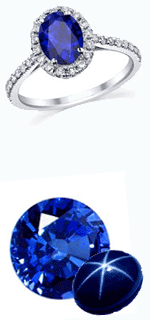| Colors: |
While blue is the most traditional and classic color for sapphire, sapphire is actually found in a variety of different colors. Colors other than blue are often referred to as fancy sapphire, such as yellow sapphire, green sapphire or purple sapphire. An intense, rich pure cornflower blue is the most desirable color. |
| Shapes: |
Ovals, cushions, and rounds are commonly seen, as are other shapes, such as fancy hearts, pears and emerald cuts. Sapphires exhibiting the star effect (asterism) are usually cut in cabochon. |
| Origin: |
Sri Lanka, Burma, Thailand, Cambodia, Australia, United States, China, Kashmir, Nigeria, Kenya and Tanzania. |
| Care: |
Protect from scratches, sharp blows and extreme temperature changes. |
| Notes: |
As a talisman, Sapphire was thought to preserve chastity, discover fraud and treachery, protect its wearer from poison, plague, fever and skin diseases, and had great power in resisting black magic and ill wishes by another. |

